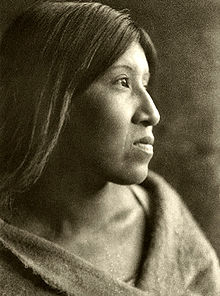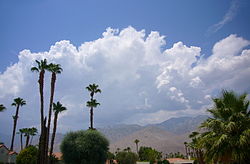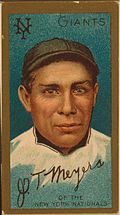- Cahuilla people
-
"Cahuilla" redirects here. For the community in California, see Cahuilla, California.
Cahuilla
Iviatim Desert Cahuilla woman by Edward S. Curtis, 1926
Desert Cahuilla woman by Edward S. Curtis, 1926
Total population 1,276 (1990)[1] Regions with significant populations  United States
United States  (California)
(California)Languages Religion Christianity (Roman Catholic, Protestant)
Related ethnic groups The Cahuilla, Iviatim in their own language, are Indians (Native Americans) with a common culture whose ancestors inhabited inland areas of southern California[1] 2,000 years ago. Their original territory included an area of about 2,400 square miles (6,200 km2). The traditional Cahuilla territory was near the geographic center of Southern California. It was bounded to the north by the San Bernardino Mountains,[1] to the south by Borrego Springs and the Chocolate Mountains, to the east by the Colorado Desert, and to the west by the San Jacinto Plain and the eastern slopes of the Palomar Mountains.[2]
Contents
Language and name
The Cahuilla language is in the Uto-Aztecan family. A 1990 census revealed 35 speakers in an ethnic population of 800. It is nearly extinct, since most speakers are middle-aged or older. In their own language, their autonym is Iviatim. Cahuilla is thought to be an exonym, the name given them by the Kawiya, meaning "master."[1]
Prehistory
Oral legends suggest that when the Cahuilla first moved into the Coachella Valley, a large body of water which geographers call Lake Cahuilla was in existence. Fed by the Colorado River, it dried up sometime before 1700, following one of the repeated shifts in the river's changed course. In 1905 a break in a levee created the much smaller Salton Sea in the same location.
The Cahuilla lived from the land by using native plants. A notable tree whose fruits they harvested is the California fan palm. The Cahuilla people also used palm leaves for basketry of many shapes, sizes and purposes; sandals, and roofing thatch for dwellings.[3] The Cahuilla lived in smaller groups than some other tribes.
History
The first encounter with Europeans was in 1774, when Juan Bautista de Anza was looking for a trade route between Sonora and Monterey in Alta California. Living far inland, the Cahuilla had little contact with Spanish soldiers or priests, nor missionaries. Many of the Europeans viewed the desert as having little or no value, but rather a place to avoid. The Cahuilla learned of Spanish missions and their culture from Indians living close to missions in San Gabriel and San Diego. The Cahuilla provided the vaqueros that worked for the owners of the Rancho San Bernardino, and provided secuity against the raids of the tribes from the desert and mountains on its herds.
The Cahuilla did not encounter Anglo-Americans until the 1840s. Chief Juan Antonio, leader of the Cahuilla Mountain Band, gave traveler Daniel Sexton access to areas near the San Gorgonio Pass in 1842. The Mountain Band also lent support to a U.S. Army expedition led by Lieutenant Edward Fitzgerald Beale, defending the party against attacks by Wakara and his band of Ute warriors.
During the Mexican-American War, Chief Juan Antonio led his warriors to join Californios led by José del Carmen Lugo in attacking their traditional enemy, the Luiseño. Lugo led this action in retaliation for the Pauma Massacre, in which the Luiseno had killed 11 Californios. The combined forces staged an ambush and killed 33-40 of the Luiseno warriors, an event that became known as the Temecula Massacre of 1847. (Academic historians disagree on the exact number of deaths, the estimate is 33-40; Luiseno oral tradition holds that more than 100 warriors were killed.) In the treaty ending the war with Mexico, the US promised to honor Mexican land grants and policies. These included recognition of Native American rights to inhabit certain lands, but European-American encroachment on Indian lands became an increasing problem after the US annexed California.
 A view of the San Jacinto Mountains, in historical Cahuilla territory.
A view of the San Jacinto Mountains, in historical Cahuilla territory.
During the 1850s, the Cahuilla came under increasing pressure from waves of European-American migrants because of the California Gold Rush. In 1851, Juan Antonio led his warriors in the distruction of the Irving Gang, a group of bandits that had been looting the San Bernardino Valley. Following the outcome of the Irving Gang incident, in late 1851, Juan Antonio, his warriors and their families, moved eastward from Politana, toward the San Gorgonio Pass and settled in a valley which branched off to the northeast from San Timoteo Canyon, at a village named Saahatpa.
In addition to the influx of Anglo-American miners, ranchers and outlaws, and groups of Mormon colonists, the Cahuilla came into conflict with the neighboring Cupeño tribe to the west. In November 1851, the Garra Revolt occurred, wherein the Cupeno leader Antonio Garra attempted to bring Juan Antonio into his revolt. Juan Antonio friendly to the Americans was instrumental in capturing Antonio Garra ending that revolt.
When the California Senate refused to ratify an 1852 treaty granting the Cahuilla control of their lands, some tribal leaders, resorted to attacks on approaching settlers and soldiers. Juan Antonio, did not participate in this as long as he lived.
To encourage the railroad, the U.S. government subdivided the lands into one-mile-square sections, giving the Indians every other section. In 1877 the government established reservation boundaries, which left the Cahuilla with only a small portion of their traditional territories.
The Cahuilla have intermarried with non-Cahuilla for the past century. A high percentage of today's Cahuilla tribal members have some degree of mixed ancestry, especially Spanish and African American. Those individuals who have grown up in the tribe's ways and identify culturally with the Cahuilla may qualify for official tribal membership by the tribe's internal rules. Each federally recognized tribe sets its own rules for membership.
Current status
Today Palm Springs and the surrounding areas are experiencing rapid development. The Agua Caliente Band of the Cahuilla is an important player in the local economy, operating an array of business enterprises, including land leasing, hotel and casino operations, and banking.
The Agua Caliente Indian Reservation occupies 126.706 km2 (48.921 sq mi) in the Palm Springs area, including parts of the cities of Palm Springs, Cathedral City, and Rancho Mirage. The total population living on its territory was 21,358 persons as of the 2000 census, although few of these are registered tribal members.
The Morongo Band of Mission Indians, also considered part of the Cahuilla nation, operates the Morongo Casino Resort and Spa, as well as the Hadley Fruit Orchards in Cabazon. The Morongo Casino is one of the largest Indian casinos in the United States. The Morongo Indian Reservation is located in northern Riverside County. The cities of Banning and Cabazon both extend partially onto reservation land. The reservation has a land area of 127.083 km2 (49.067 sq mi), with a resident population of 954, the majority of Native American heritage.
Smaller bands of Cahuilla are located in Southern California: the Augustine Band in Coachella; the Cabazon Band in Indio; the Cabazon Reservations in Indio, Coachella and Mecca; the Cahuilla Band in Anza; the Los Coyotes Band in Warner Springs; the Ramona Indian Reservation in Pine Meadow; Santa Rosa Indian Reservation in Pinyon; the Twentynine Palms Band in Twentynine Palms, Indio and Coachella; the Torres-Martinez Band in La Quinta, Coachella, Thermal, Mecca and Oasis; and the Mission Creek Reservation in Desert Hot Springs.
Extinct Cahuilla tribes (known as the Las Palmas bands of Cahuilla) in the early 20th century resided in the Palm Desert area (between Cathedral City and La Quinta). This was before land developers and US Armed Forces purchased what was tribal land from the Montoya family in present-day Indian Wells and from the San Cayetano band in Rancho Mirage. The number of these tribes' descendants is unknown. The Montoya family, who claim partial Cahuilla descent, are influential in local economics and city politics.
The ethnic composition of the Cahuilla descendants is like that of many other Americans: mixed with European (especially Anglo/Irish-American and Spanish), African American, Asian-American (from historic interaction with Chinese railroad workers and Filipino farm laborers), and other tribal groups, mainly Apache migrant workers from Arizona. Some Cahuilla families continue to intermarry with local populations; others try to marry within Native American tribes.
Federally recognized tribes
The Cahuilla have been historically divided into "Mountain," "Desert," and "Pass" groups by anthropologists. Today there are nine Southern California reservations that are acknowledged homes to bands of Cahuilla people. These are located in Imperial, Riverside and San Diego counties and are the territory of federally recognized tribes.
Federally recognized Cahuilla bands are:
- Agua Caliente Band of Cahuilla Indians of the Agua Caliente Indian Reservation, California;
- Augustine Band of Cahuilla Indians (the smallest federally recognized Native American tribe, with eight persons),[4]
- Cabazon Band of Mission Indians, California;
- Cahuilla Band of Mission Indians of the Cahuilla Reservation, California;
- Los Coyotes Band of Cahuilla & Cupeno Indians of the Los Coyotes Reservation, California;
- Morongo Band of Cahuilla Mission Indians of the Morongo Reservation, California;
- Ramona Band or Village of Cahuilla Mission Indians of California;
- Santa Rosa Band of Cahuilla Indians, California; and
- Torres-Martinez Desert Cahuilla Indians, California.
Notable Cahuilla
- Marigold Linton (Morongo Band, b. 1936), cognitive psychologist
- John Tortes "Chief" Meyers (Cahuilla Band, 1880–1971), Major League baseball catcher
- Katherine Siva Saubel (Los Coyotes, 1920–2011), language preservationist and former tribal chairperson
See also
- Cahuilla mythology
- Muut
- Cahuilla traditional narratives
- Golden Checkerboard
- O. M. Wozencraft negotiated the Treaty of Temecula on January 5, 1852.[5]
Notes
- ^ a b c d "California Indians and Their Reservations. SDSU Libray and Information Access. (retrieved 12 Dec 2009)
- ^ Bean, 1978
- ^ C. Michael Hogan. 2009
- ^ May, James. "Eight-member Augustine tribe opens casino." Indian County Today. 30 July 2002 (retrieved 25 February 2009)
- ^ CARRICO, RICHARD L. (Summer 1980). "San Diego Indians and the Federal Government Years of Neglect, 1850-1865". The Journal of San Diego History. San Diego Historical Society. https://www.sandiegohistory.org/journal/80summer/neglect.htm. Retrieved 22 June 2010.
References
- Bean, Lowell John. (1972) Mukat's People: The Cahuilla Indians of Southern California. University of California Press, Berkeley.
- Bean, Lowell John. (1978) "Cahuilla", in California, edited by Robert F. Heizer, pp. 575–587. Handbook of North American Indians, William C. Sturtevant, general editor, vol. 8. Smithsonian Institution, Washington, D.C.
- Bean, Lowell John, Sylvia Brakke Vane, and Jackson Young. (1991) The Cahuilla Landscape: The Santa Rosa and San Jacinto Mountains. Menlo Park, CA: Ballena Press
- Hogan, C. Michael. 2009. California Fan Palm: Washingtonia filifera, GlobalTwitcher.com, ed. Nicklas Stromberg
- Kroeber, A. L. (1925) Handbook of the Indians of California. Bureau of American Ethnology Bulletin No. 78. Washington, D.C.
- James, Harry C. (1969) The Cahuilla Indians, Banning, CA: Malki Museum Press, .
Further reading
- Apodaca, Paul (with Luke Madrigal). 1999. "Cahuilla bird songs", California Chronicles, 2(2): 4-8.
- Kroeber, A.L. (1908) Ethnography of the Cahuilla Indians. Kessinger Publishing, LLC (2007 reprint) ISBN 0548681074 ISBN 978-0548681077
External links
- Home page Agua Caliente Band
- Frazer, Robert W. (ed.) (1976). "Lovell's Report on the Cahuilla Indians: 1854." The Journal of San Diego History 22 (1).
- Agua Caliente Reservation and Morongo Reservation, California United States Census Bureau
Indigenous peoples of California Achomawi · Atsugewi · Bay Miwok · Cahuilla · Chemehuevi · Chimariko · Chumash · Coast Miwok · Cupeño · Eel River Athapaskans (Lassik, Nongatl, Sinkyone, Wailaki) · Esselen · Gabrielino (Tongva) · Halchidhoma · Hupa (Chilula, Whilkut) · Juaneño (Acjachemen) · Karuk · Kato · Kawaiisu · Kitanemuk · Kumeyaay (Diegueño, Ipai, Tipai) · Lake Miwok · Luiseño · Maidu · Mattole (Bear River) · Modoc (Klamath) · Mohave · Mono (Monache, Owens Valley Paiute) · Nomlaki · Northern Paiute · Ohlone (Costanoan) · Patwin · Pomo · Quechan (Yuma) · Salinan · Serrano · Shasta (Konomihu, Okwanuchu) · Tataviam · Timbisha · Tolowa · Tübatulabal · Valley and Sierra Miwok · Wappo · Washoe · Wintu · Wiyot · Yana · Yokuts · Yuki · Yurok
Categories:- Cahuilla
- California Mission Indians
- Native American tribes in Riverside County, California
- Native American tribes in California
- Federally recognized tribes in the United States
- Colorado Desert
Wikimedia Foundation. 2010.

